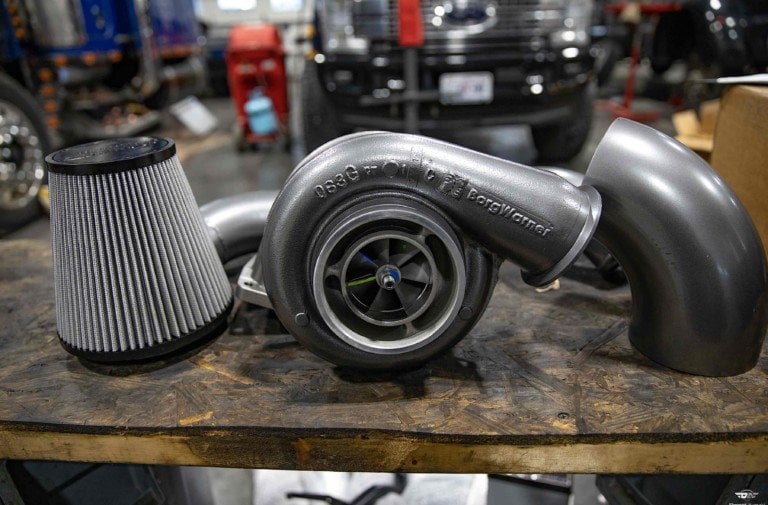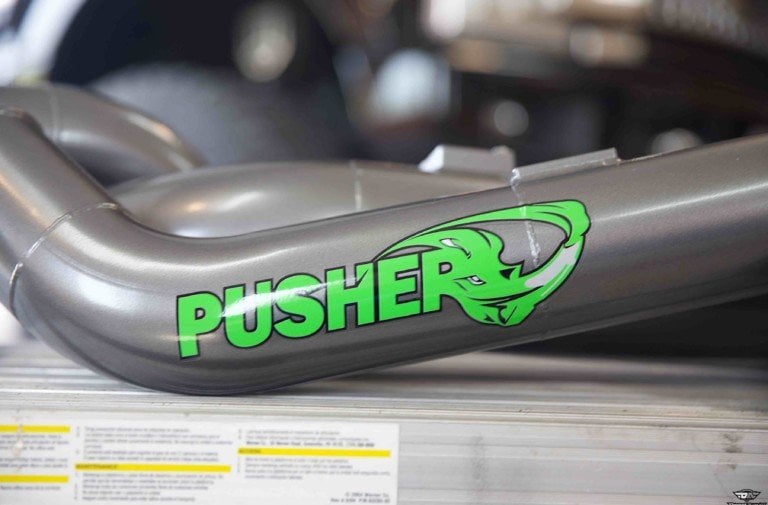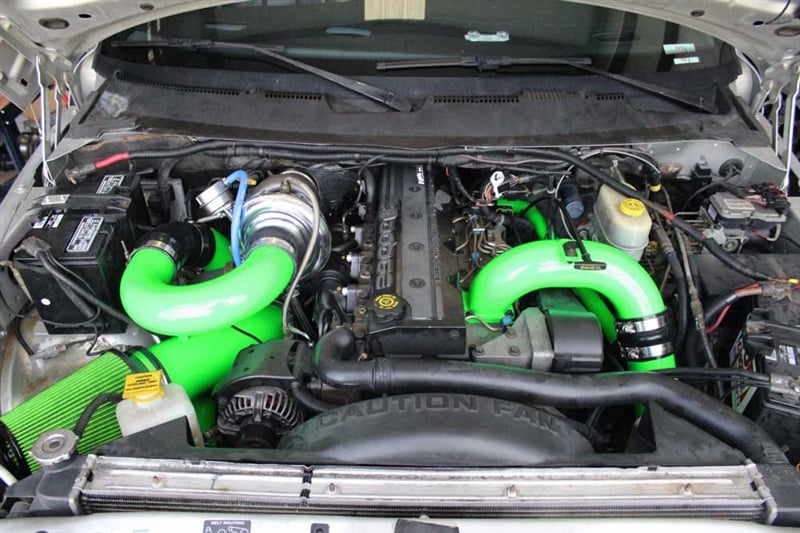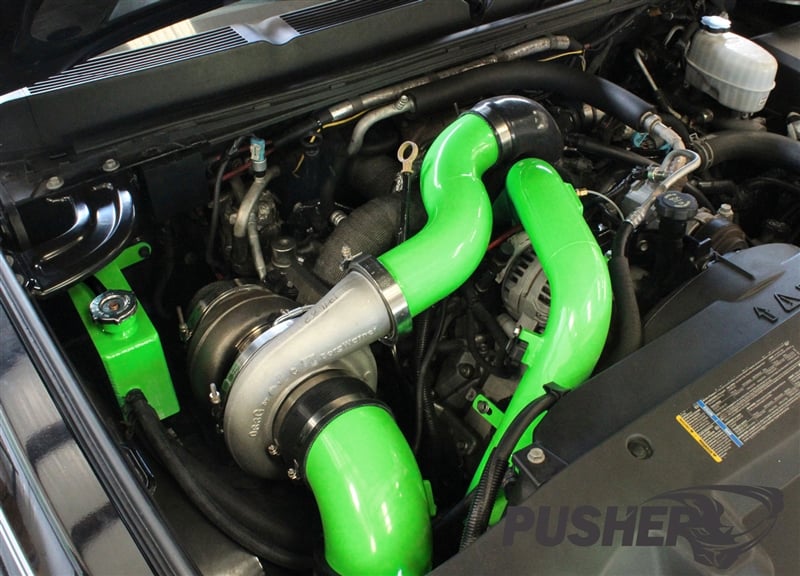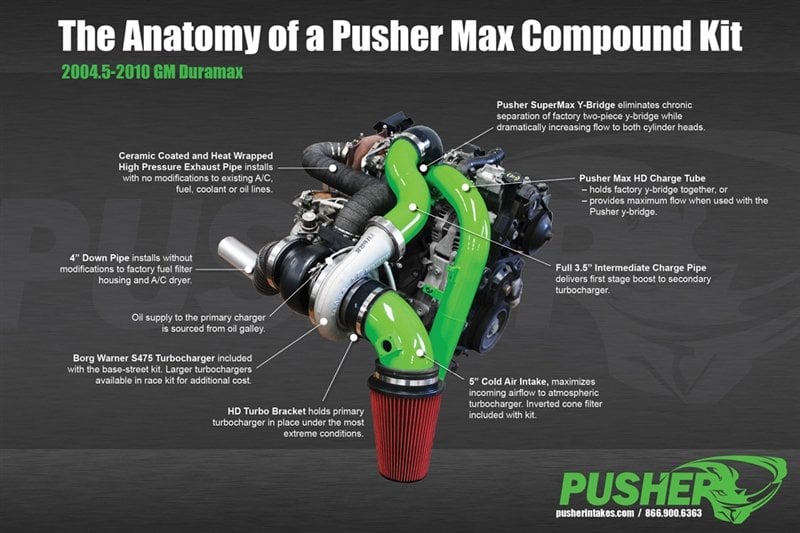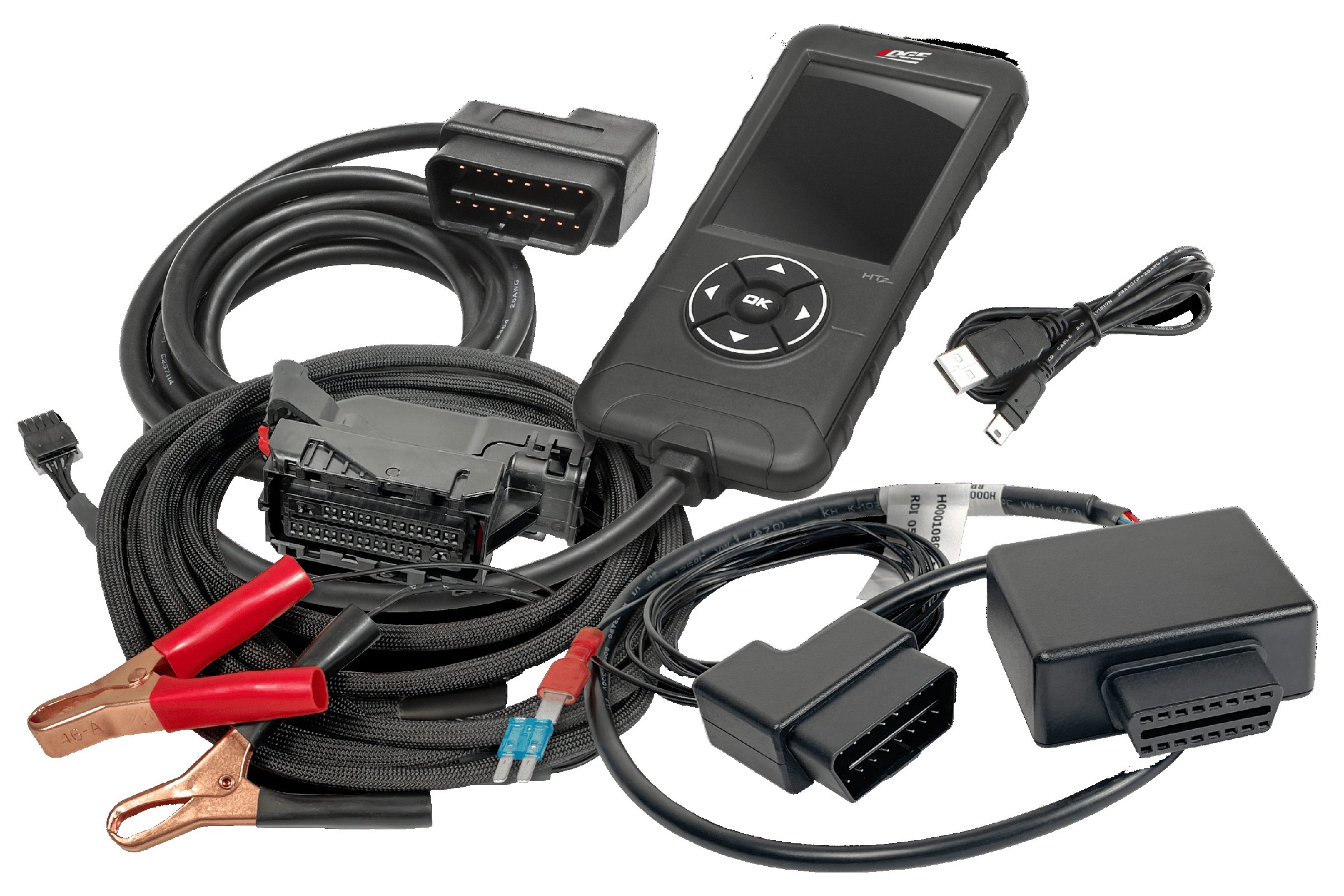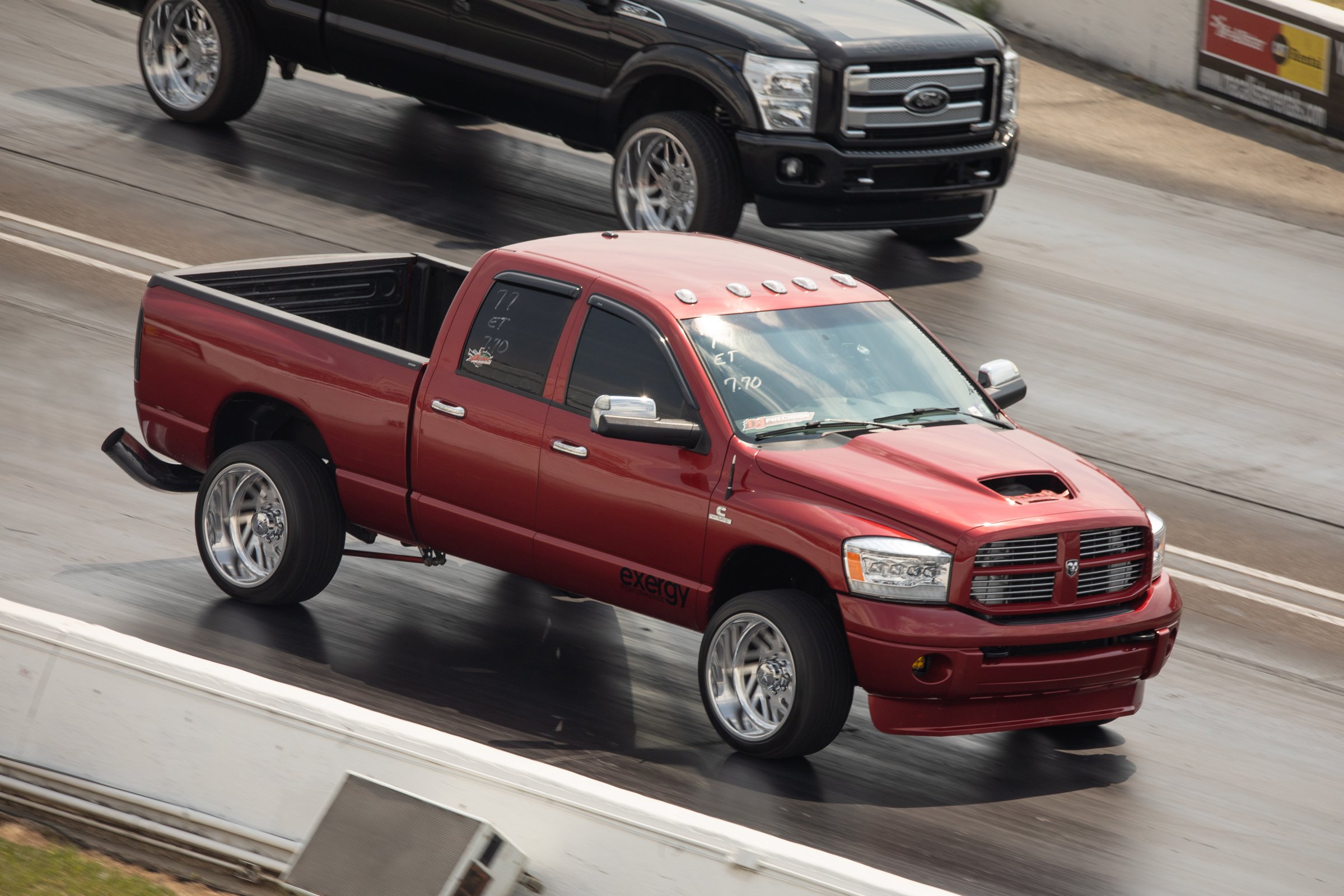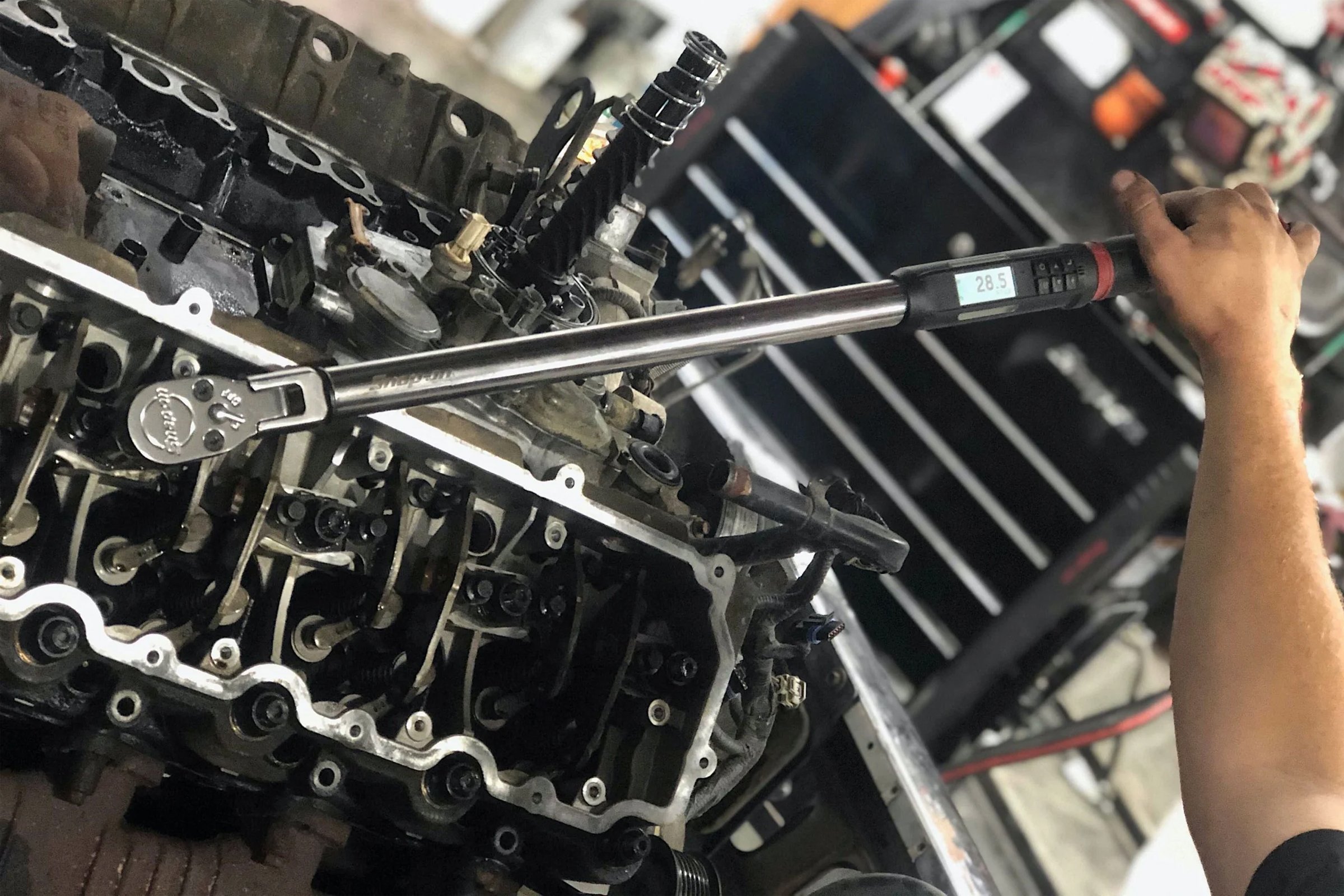It seems as if there are quite a few questions about compound turbos and the diesel engine. Enthusiasts know what they are but most still have questions. Many can recognize what compound turbos look like but don’t know how they work and I think it’s important to set the record straight with some of the industry’s experts. For this piece, I’ll be working alongside Jacob Allenbaugh, owner of Pusher Intakes, to see what we can learn about compound turbo systems in today’s world.
Instead of just hitting the ground running, we thought it was important to lay out the most asked questions and discuss them individually. After being in business for as long as they have, the company has plenty of inquiries about anything and everything turbocharger systems.

The most common question that both Pusher and other industry experts get is “What are compounds? How do they work?” While this is a loaded question, here is what we have come up with.
What Are Compound Turbos And How Do They Work?
“These highly popular systems make incredible efficiency and power by combining two turbochargers, in which one turbocharger feeds the other to create double the intake pressure (commonly referred to as boost). In these systems, there is a primary (small) high-pressure turbo and a secondary (big) atmospheric turbo. The primary turbo receives the exhaust flow first, and given its lightweight and smaller nature, it quickly powers low engine RPM boost,” Allenbaugh said.
“Continuing on its way, the exhaust leaving the primary turbo is routed over to the secondary turbo. Where the magic starts to happen is once the primary turbo begins to reach its maximum desired RPM – that’s when the vanes/wastegate open, bypassing exhaust around its turbine wheel and directly into the secondary turbo effectively ‘handing over the baton’ so your engine can continue to easily create boost in the mid-to-upper engine RPMs.”
“On the intake side of things, people are generally surprised to find the flow is opposite of what they suspect. The secondary turbo sucks air from the atmosphere (hence its name) and pressurizes it, then feeds it to the primary turbo which pressurizes it further. A compound turbo system is sometimes incorrectly referred to as “twins”. Twins are turbos in parallel with each other; they operate independently of each other. They are generally used on V-type engines where each turbo is fed exhaust by its respective bank, and the charge air from each turbo is then fed into the same area (intercooler then engine). This is a single-stage system whereas a compound system is considered two-stage.”
“A simple analogy when comparing these two different types of systems is to consider batteries. When you connect two batteries together in a series they make twice the voltage, which can be equated to pressure in a compound turbo system. On the contrary, when you connect two batteries in parallel they create twice the amperage, which would be equated to your flow rate on a twin turbocharger system.”
Ultimately both systems achieve the same result, but their platform application is very different. Twins are often used on gas-powered engines because they can turn about twice the RPM a diesel can. The only way to generate the same power output in a diesel is to increase the pressure of the air delivery.”
Now that we have a better understanding of what compound turbo systems are, what other kinds of questions could be asked? According to Pusher, they are often asked if compound turbos are a “race only” option.
Compound Turbos: Aren’t They Just For Race Trucks?
“Surprising to many, compound systems have been around for quite some time in many different OEM forms (consider the 6.4L Powerstrokes, which came with factory compounds). However, their initial rise in the diesel community’s awareness primarily came from the early days of light-duty diesels becoming a popular competition platform, which led many people to make the assumption that only highly modified “race” trucks would dabble in compound systems. But consider the benefits of a compound turbo system: greater efficiency, reliable power through all RPM levels, considerably lower and stabilized EGT temps – these are benefits that lend themselves to all owners (especially for towing – where efficiency, power, and EGTs suffer the most),” Allenbaugh explained.
“Ironically, the race opinion has been shifting away from compounds toward a single big turbo combined with a shot of nitrous as the way to go in the drag race and dyno applications; there are so many more options available now that the broad power and benefits of compounds for racing can be replaced with finer tuned and purposefully designed big racing singles. In my opinion, absolutely not. Although a large set of compound turbos make for a ton of usable air which will inevitably support a lot of horsepower, when you properly set up a compound turbo system, you can make them for every scenario. In fact, last year we tested a compound turbo system from Pusher for towing.”
Traveling all across the country with a compound turbo system gets better mileage, has more power faster, lower exhaust temperatures, and also a much better sound under the hood.
Even with compound turbos explained, some people still have questions and that is all right. Another common question even with an understanding is what is wrong with my factory turbo? Is it not enough for what I do? I think that the factory turbos are enough but they are a restriction.
In my opinion, If you’re wanting to get everything you possibly can out of this setup, why not upgrade it? There are plenty of “add-a-turbo” kits out there that utilize a factory turbo. What I did was use a BD Diesel HE351 Screamer turbo on my 2011 6.7 Cummins. It’s the factory size, just capable of much more.
Why Is My Single Turbo Or Factory Turbo Not Enough?

Project TowBoat is locked and loaded with compounds and normal driving, towing, and street ripping are effortless.
“A single turbo is a very simple and effective way to make good power, but (and this is a big but), they can only cover a given range of power effectively. Aftermarket single turbos are often bigger, giving the trucks great top-end power. But ask the small turbo to give you top-end power, or ask the large turbo to give you great throttle response, and you’ll be left with lackluster performance. Each has its pros and cons, and that’s where the beauty of running these two sizes together makes itself clear”
“A compound system will not make your truck less reliable – but by adding them to your truck you’ve unlocked a whole lot of additional potential. Our base compound systems provide enough air for 700-750hp. If you decide to tackle that potential and add additional mods (fuel, injectors, etc) then it’s important to note that 700hp and 500hp are not the same things. More power is more load and wears on parts, period. Setting up your truck the right way will minimize accelerated wear, but as a rule of thumb: more power wears parts faster. You can’t expect to play at 700hp all the time and get the same life out of your drivetrain that you would at 500hp. But again, it’s not the compounds that are increasing that potential wear. Your truck is going to be a whole lot safer and more reliable at the 500hp mark and below with compounds than it is trying to make that same power with the factory charger.”
“Yes, but nothing too crazy. Tuning mainly comes down to what you have on the truck already, or plan to add at the same time. If you’re just bolting on compounds on an older truck with a fixed geometry turbo, the only change you’ll need to make is to set your wastegate to open sooner, which we cover in our instruction manuals. On the newer trucks equipped with a MAF sensor and variable geometry turbos, you will have to set up the MAF for our larger cold air intake and have the vanes open earlier, but that’s pretty simple stuff that is also covered in our instructions.”
“A great example here is our new compound system for the 6.7L Fords – we looked hard at keeping the factory-sized passenger side battery in the engine compartment with the additional turbo, but at the end of the day there was no way I would want to own a truck with all of those components just crammed in there. So we put the atmospheric where it was best suited for routing, and then from there figured out what had to be done to accommodate that. As a result, prioritizing that routing required a smaller, higher-performing battery and a new low-pressure AC line – both of which raised the cost of the system. But now have the only system that fits easily into those models, and routes optimally in the engine bay. No rubbing parts, significantly easier to install and way easier to maintain. A small price to pay for such a big difference.”
“The same thing goes for our Duramax-specific systems, keeping the factory battery and coolant reservoir under the hood is just too tight. Fortunately, the trucks have enough battery cable in the harness to reach where the passenger side battery is located on the frame rail like the vans. So we’re able to supply to OEM battery tray that the vans use so you have a factory-like set up there, and then we supply a new all-aluminum coolant reservoir which is lower profile and mounts where the battery was. With that done the engine bay is so much more open, and so much easier to work on.”
- How is the atmospheric supported/bolted onto the engine? This is going to directly affect the durability of the system. We’ve sold a lot of systems to customers that unfortunately bought a system with an inadequately mounted (or not mounted at all) atmospheric turbo and the system fails pretty quickly.
- Where is the atmospheric turbo placed? This is going to dictate how the rest of the system is designed, and how hard it is to install.
- Are irreversible modifications to the surrounding engine bay components necessary?
- Will it be easier, or more difficult to work on the truck after installation?
- How is the system made? Is it made on a mockup engine or in dedicated weld fixtures? There are a lot of kits out there made in a “one-off manner” which means their fitment can vary greatly from one to the next.
- How is the oil drain configured? The later model Cummins trucks have an auxiliary oil drain port right on the side of the turbo side of the block which is awesome for returning oil from the atmospheric turbo. The Duramax and Powerstrokes are not so easy. You should look into what is involved with plumbing return oil back in, and where it’s going when it gets there. Is it above or below the oil line in the pan?
- How unique are the components supplied in the system? If you have a silicone coupler fail, is it a relatively standard size/shape or can you only get it from the manufacturer of the compound system? What if they stop making that design or are on backorder?
- What is the quality level of the small components provided? Are the clamps all stainless? Are the hoses, bolts, gaskets, etc up to par and from reputable manufacturers?
- Are instructions and hardware included? (You would think it would be a resounding yes across the board, but it’s not).
“The bottom line is there are a lot of ways to design a compound system and a lot of options to consider. I encourage you to do the research and educate yourself on each system you think fits your needs,” said Allenbaugh. We cannot thank Jacob and Elizabeth at Pusher Intakes enough for taking the time out of their busy schedule to work with us on this story.
The entire family at Pusher Intakes is passionate about turbos and turbo systems and it shows. They took the time out to answer our questions so we could share their knowledge with you, our readers, and educate you on compound turbos before you pull the trigger on a kit that will not work as well. We just want you to get the best bang for your buck.
If you’re ready to dive into this project more, head on over to the Pusher Intakes website here. You can find exactly what fits your vehicle, find out exactly what you can expect afterward, and you get your truck to the next level of efficiency. Stay tuned right here at Diesel Army for more technical stories like this one, more interviews, truck features, and event features.




